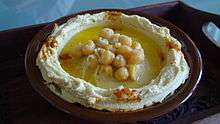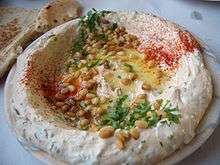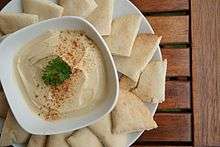Hummus
Hummus (/ˈhʊməs/, /ˈhʌməs/;[1][2] Arabic: حُمُّص, 'chickpeas'; full Arabic name: ḥummuṣ bi-ṭ-ṭaḥīna Arabic: حمص بالطحينة, 'chickpeas in tahini') is a dip, spread, or savory dish made from cooked, mashed chickpeas blended with tahini, lemon juice, and garlic.[3] It is popular in the Middle East and in Middle Eastern cuisine around the globe. It can also be found in most grocery stores in North America and Europe.
.jpg) Hummus dip with chickpeas, sesame seeds, and oil | |
| Alternative names | Hommos, houmous |
|---|---|
| Course | Meze |
| Place of origin | Middle East |
| Serving temperature | Room temperature or warm |
| Main ingredients | Chickpeas, tahini |
Etymology and spelling
| Look up hummus in Wiktionary, the free dictionary. |
"Hummus" comes from the Arabic word ḥummuṣ meaning "chickpeas", a variant of ḥimmaṣ or ḥimmiṣ. It may be of Aramaic origin, corresponding to the Syriac word for chickpeas: ḥem(m)ṣē.[4] The full name of the prepared spread in Arabic is ḥummuṣ bi ṭaḥīna which means "chickpeas with tahini".[5]
Spelling of the word in English can be inconsistent, though most major dictionaries from American and British publishers give hummus as the primary spelling. Some American dictionaries give hommos as an alternative, while British dictionaries give houmous or hoummos.[6][2][4] Other spellings include homous, houmos, houmus, and similar variants. While humus (as it is spelled in Turkish) is sometimes found, it is generally avoided as it conflicts with another English word that refers to organic matter in soil.[6]
Origin and history

Although multiple different theories and claims of origins exist in various parts of the Middle East, evidence is insufficient to determine the precise location or time of the invention of hummus.[7] Its basic ingredients—chickpeas, sesame, lemon, and garlic—have been combined and eaten in the Levant over centuries.[8][9] Though regional populations widely ate chickpeas, and often cooked them in stews and other hot dishes,[10] puréed chickpeas eaten cold with tahini do not appear before the Abbasid period in Egypt and the Levant.[11]
The earliest known written recipes for a dish resembling hummus bi tahina are recorded in cookbooks written in Cairo in the 13th century.[7][12] A cold purée of chickpeas with vinegar and pickled lemons with herbs, spices, and oil, but no tahini or garlic, appears in the Kanz al-Fawa'id fi Tanwi' al-Mawa'id;[11] and a purée of chickpeas and tahini called hummus kasa appears in the Kitab Wasf al-Atima al-Mutada: it is based on puréed chickpeas and tahini, and acidulated with vinegar (though not lemon), but it also contains many spices, herbs, and nuts, and no garlic. It is also served by rolling it out and letting it sit overnight,[13] which presumably gives it a very different texture from hummus bi tahina.
Regional preparations


As an appetizer and dip, diners scoop hummus with flatbread, such as pita.[14] It is also served as part of a meze or as an accompaniment to falafel, grilled chicken, fish, or eggplant.[14] Garnishes include chopped tomato, cucumber, coriander, parsley, caramelized onions, sautéed mushrooms, whole chickpeas, olive oil, hard-boiled eggs, paprika, sumac, ful, olives, pickles, and pine nuts. Outside the Middle East, it is sometimes served with tortilla chips or crackers.
Hummus ful (pronounced [fuːl]) is topped with a paste made from fava beans boiled until soft and then crushed. Hummus msabbaha/mashawsha is a mixture of hummus paste, warm chickpeas, and tahini.
Hummus is a popular dip in Egypt where it is eaten with pita,[15] and frequently flavored with cumin or other spices.[14][15][16]
For Palestinians and Jordanians, hummus has long been a staple food, often served as a warm dish, with bread for breakfast, lunch or dinner. All of the ingredients in hummus are easily found in Palestinian gardens, farms and markets, thus adding to the availability and popularity of the dish. In Palestine, hummus is usually garnished, with olive oil, "nana" mint leaves, paprika, and parsley.[17] A related dish popular in Palestine and Jordan is laban ma' hummus ("yogurt and chickpeas"), which uses yogurt in the place of tahini and butter in the place of olive oil and is topped with pieces of toasted bread.
Hummus is a common part of everyday meals in Israel. It is made from ingredients that, following Kashrut (Jewish dietary laws), can be combined with both meat and dairy meals. Jewish immigrants arriving from Europe in the late 19th and early 20th century adopted much of the local Palestinian cuisine, including hummus, though it traditionally has been part of the cuisine of the Mizrahi Jews who lived in Arabic-speaking lands. The many Mizrahi Jewish immigrants from these countries brought their own unique variations, such as hummus with fried eggplant and boiled eggs prepared by Iraqi Jews, and Hasa Al Hummus, a chickpea soup preferred by Moroccans. The Yemenite quarter of Tel Aviv is known for its hummus with traditional skhug hot sauce. More recently, African immigrants have brought specialties such as Sudanese Hummus Darfur, with eggs, tomatoes, and grated cheese. Arab Israelis and Jews alike seek out authentic hummus in Arab hummusia, restaurants specializing in hummus dishes, making famous such Arab villages as Abu Gosh and Kafr Yasif. Enthusiasts travel to the more remote Arab and Druze villages in the northern Galilee region in search of the perfect hummus experience.[14][18][19]
Although sometimes criticized as Jewish appropriation of Palestinian and Arab culture,[20] hummus has been adopted as an unofficial "national dish" of Israel, reflecting its huge popularity and significance among the entire Israeli population.[14] Many restaurants run by Mizrahi Jews and Arab citizens of Israel are dedicated to warm hummus,[14] which may be served as chick peas softened with baking soda along with garlic, olive oil, cumin and tahini. One of the hummus versions available is msabbaha, made with lemon-spiked tahini garnished with whole chick peas, a sprinkling of paprika and a drizzle of olive oil.[21]
One author calls hummus, "One of the most popular and best-known of all Syrian dishes" and a "must on any mezzeh table."[22] Syrian and Lebanese in Canada's Arab diaspora prepare and consume hummus along with other dishes like falafel, kibbeh and tabbouleh, even among the third- and fourth-generation offspring of the original immigrants.[23]
In Cyprus, hummus is part of the local cuisine in both Turkish Cypriot and Greek Cypriot communities where it is called "humoi" (Greek: χούμοι).[24][25] In the United Kingdom, hummus was popularized by Greek Cypriot caterers, sometimes leading to a perception of it being a Greek food,[26] though it is not well known in Greece.
In Turkey, hummus is considered a meze[27] and usually oven-dried with pastırma, which differs from the traditional serving.
In the United States and Europe, hummus is commercially available in numerous traditional and non-traditional varieties, such as beet or chocolate.[28] It is also sometimes used as a pizza topping.[29]
Nutrition
Chickpeas, the main ingredient of conventional hummus, have appreciable amounts of dietary fiber, protein, vitamin B6, manganese and other nutrients.[30]
As hummus recipes vary, so does nutritional content, depending primarily on the relative proportions of chickpeas, tahini, and water. Hummus provides roughly 170 calories for 100 grams, and is a good to excellent (more than 10% of the Daily Value) source of dietary fiber, vitamin B6, and several dietary minerals.[31][32]
Fat content, mostly from tahini and olive oil, is about 14% of the total; other major components are 65% water, 17% total carbohydrates, including a small amount of sugar, and about 10% protein.[31][32]
Packaged product
United States
In 2006, hummus was present in 12 percent of American households, rising to 17 percent by early 2009.[33] One commentator attributed the growth of hummus to America’s embrace of ethnic and exotic foods.[33]
While in 2006–08 when some 15 million Americans consumed hummus, and annual national sales were about $5 million, sales growth in 2016 was reflected by an estimated 25% of US households consuming hummus.[34] By 2016, the leading American hummus manufacturer, Sabra Dipping Company, held a 62% market share for hummus sales in the United States, and was forecast to exceed $1 billion in sales in 2017.[34][35][36] To meet the rising consumer demand for hummus, American farmers increased their production of chickpeas four-fold since 2009, harvesting more than 100,000,000 pounds (45,000,000 kg) in 2015, an increase from 25,000,000 pounds (11,000,000 kg) in 2009.[34] Hummus consumption has been so popular, many tobacco farmers have switched to growing chickpeas to meet demand.[37]
Culture
In October 2008, the Association of Lebanese Industrialists petitioned to the Lebanese Ministry of Economy and Trade to request protected status from the European Commission for hummus as a uniquely Lebanese food, similar to the Protected Geographical Status rights held over regional food items by various European Union countries.[38][39][40] As of late 2009, the Lebanese Industrialists Association was still "collecting documents and proof" to support its claim.[41]
The 2005 short film West Bank Story features a rivalry between two fictional restaurants, the Israeli "Kosher King" and the Palestinian "Hummus Hut". A parody of West Side Story, which is itself an adaptation of Romeo and Juliet, the film won the 2006 Academy Award for Best Live Action Short Film.[42] In 2012, Australian filmmaker Trevor Graham released a documentary, Make Hummus Not War, on the political and gastronomic aspects of hummus.[43]
In May 2010, the Guinness World Record for the largest dish of hummus in the world returned to Lebanon.[44][45] The winning dish, cooked by 300 cooks in the village of al-Fanar, near Beirut, weighed approximately 10,450 kilograms (23,040 lb), more than double the weight of the previous record.[46][47][48] According to local media, the recipe included eight tons of boiled chick peas, two tonnes of tahini, two tonnes of lemon juice, and 70 kilograms (150 lb) of olive oil.[44]
See also
| Wikimedia Commons has media related to Hummus. |
- Bean dip
- List of dips
- List of hors d'oeuvre
- List of legume dishes
- Msabbaha
References
- "hummus Meaning in the Cambridge English Dictionary". dictionary.cambridge.org. Archived from the original on 7 August 2017. Retrieved 27 April 2018.
- "hummus - Definition of hummus in English by Oxford Dictionaries". Oxford Dictionaries - English. Archived from the original on 17 July 2016. Retrieved 27 April 2018.
- Davidson, Alan (21 August 2014). The Oxford Companion to Food. OUP Oxford. ISBN 9780191040726 – via Google Books.
- "American Heritage Dictionary Entry: hummus". The American Heritage Dictionary of the English Language. Archived from the original on 7 August 2017. Retrieved 27 April 2018.
- Maan Z. Madina, Arabic-English Dictionary of the Modern Literary Language, 1973, s.v. ح م ص
- Pam Peters (2007), The Cambridge Guide to Australian English Usage, Cambridge University Press, p. 370, ISBN 0-521-87821-7
- Spechler, Diana (11 December 2017). "Who invented hummus?". BBC. Retrieved 14 January 2019.
- Tannahill p. 25, 61
- Brothwell & Brothwell passim
- e.g. a "simple dish" of meat, pulses and spices Muhammad bin Hasan al-Baghdadi described in the 13th century, Tannahill p. 174
- Lilia Zaouali, Medieval Cuisine of the Islamic World, University of California Press, 2007, ISBN 978-0-520-26174-7, translation of L'Islam a tavola (2004), p. 65
- Encyclopedia of Jewish Food, John Wiley & Sons, 2010, By Gil Marks, page 270
- Perry et al., p. 383
- Raz, Dan Savery (1 August 2015). "Hunting for hummus in Israel". BBC Travel. Archived from the original on 7 February 2017. Retrieved 7 February 2017.
- Pateman, Robert; El-Hamamsy, Salwa (2003) [1993]. Egypt. Tarrytown, N.Y.: Marshall Cavendish Benchmark. p. 123. ISBN 978-0-7614-1670-8.
- Rombauer, Irma S.; Becker, Marion Rombauer; Becker, Ethan (2002). All about Party Foods & Drinks. New York: Scribner. p. 30. ISBN 978-0-7432-1679-1.
- Ibrahim, Lailie, Institute for Middle East Understanding, Hummus, a Palestinian staple Archived 1 December 2008 at the Wayback Machine, 31 March 2006. Retrieved 9 March 2008.
- Yotam Ottolenghi (29 June 2010). "The perfect hummus debate". The Guardian. Archived from the original on 26 December 2016.
- Marks, Gil (17 November 2010). Encyclopedia of Jewish Food. HMH. ISBN 9780544186316 – via Google Books.
- Mitnick, Joshua (25 July 2007). "Hummus brings Israelis, Palestinians to the table". Christian Science Monitor. ISSN 0882-7729. Retrieved 29 August 2018 – via Christian Science Monitor.
- Food & Wine, May 2008; On the Hummus Hunt in Israel Archived 8 June 2008 at the Wayback Machine by Jen Murphy, p. 66,
- Arto der Hartoiunian Vegetarian Dishes from the Middle East, London 1983, p.33.
- Paul Robert Magocsi (1999), Encyclopedia of Canada's Peoples, University of Toronto Press, p. 1244, ISBN 0-8020-2938-8
- "Traditional food of Cyprus". delac.eu. D.E.L.A.C. Archived from the original on 5 March 2016. Retrieved 30 November 2015.
- "Cyprus foods, traditional dishes and recipes". Life in Cyprus, a view from the inside. Archived from the original on 8 December 2015. Retrieved 30 November 2015.
- Sami Zubaida, "National, Communal and Global Dimensions in Middle Eastern Food Cultures" in Sami Zubaida and Richard Tapper, A Taste of Thyme: Culinary Cultures of the Middle East, London and New York, 1994 and 2000, ISBN 1-86064-603-4, p. 35.
- Shulman, Martha Rose (30 October 2007). Mediterranean Harvest: Vegetarian Recipes from the World's Healthiest Cuisine. Rodale. ISBN 9781594862342. Archived from the original on 14 October 2017.
- "Sabra Is Finally Releasing Chocolate Hummus Just in Time for Valentine's Day". PEOPLE.com. Retrieved 11 February 2020.
- Kamila, Avery Yale (2 February 2020). "Hummus pizza is rising: A mash-up of Middle Eastern hummus with Italian pizza". Portland Press Herald. Retrieved 11 February 2020.
- "Chickpeas (garbanzo beans, bengal gram), mature seeds, canned per 100 grams". Nutritiondata.com from Conde Nast; republished from the USDA National Nutrient Database, version SR-21. 2014. Archived from the original on 19 May 2016. Retrieved 12 May 2016.
- "Hummus, commercial per 100 grams". Nutritiondata.com from Conde Nast; republished from the USDA National Nutrient Database, version SR-21. 2014. Archived from the original on 4 May 2016. Retrieved 12 May 2016.
- "Hummus, homemade per 100 grams". Nutritiondata.com from Conde Nast; republished from the USDA National Nutrient Database, version SR-21. 2014. Archived from the original on 12 May 2016. Retrieved 12 May 2016.
- There’s Hummus Among Us Archived 1 September 2011 at Wikiwix By Elena Ferretti, Fox News, April 5, 2010
- Justin R. Silverman (20 April 2016). "Hummus's quest to conquer America, one mouth at a time". Today. Archived from the original on 7 November 2017. Retrieved 1 November 2017.
- Scott Goodson (5 June 2015). "The Surprising Rise of Hummus in America". Huffington Post. Archived from the original on 29 September 2017. Retrieved 1 November 2017.
- Elaine Watson (29 September 2016). "Sabra 'well on its way' to becoming our next $1bn brand, says PepsiCo". Foodnavigator-USA.com, William Reed Business Media. Archived from the original on 27 April 2018. Retrieved 1 November 2017.
- Hainer, Michelle. "Hummus is so popular, tobacco farmers switch to chickpeas". today.com. Archived from the original on 10 January 2018. Retrieved 27 April 2018.
- Karam, Zeina, "Hummus war looms between Lebanon and Israel Archived 15 July 2012 at the Wayback Machine", Associated Press, 7 October 2008. Retrieved 10 December 2008.
- Carolynne Wheeler (11 October 2008), "Hummus food fight between Lebanon and Israel", The Daily Telegraph, archived from the original on 18 February 2018
- "Whose hummus is it anyway?", The Times of South Africa, 9 November 2008, archived from the original on 20 November 2008
- "Lebanese to Israel: Hands Off Our Hummus!". Haaretz. Associated Press. 24 October 2009. Archived from the original on 4 March 2016. Retrieved 23 February 2016.
- Anderman, Nirit (26 February 2007). "Musical Comedy on West Bank Wins Oscar for Best Live Action Short Film". Haaretz. Retrieved 29 August 2018 – via Haaretz.
- Rutledge, David (11 March 2015). "Make hummus not war". ABC Australia. Archived from the original on 24 November 2015. Retrieved 29 November 2015.
- Staff, By the CNN Wire. "Lebanon claims latest title in 'Hummus War'". cnn.com. Archived from the original on 22 April 2018. Retrieved 27 April 2018.
- "Lebanon breaks Israel's hummus world record". Gulf News, Lebanon: Al Nisr Publishing LLC. 9 May 2010. Archived from the original on 7 April 2017.
- "Abu Gosh mashes up world's largest hummus". YNet. AFP. 8 January 2010. Archived from the original on 14 January 2010.
- "Abu Ghosh secures Guinness world record for largest dish of hummus". Israel Ministry of Foreign Affairs. 11 January 2010. Archived from the original on 6 March 2011. Retrieved 31 March 2010.
- Jack Brockbank (12 January 2010). "The largest serving of hummus". Guinness World Records. Archived from the original on 5 April 2010. Retrieved 31 March 2010.